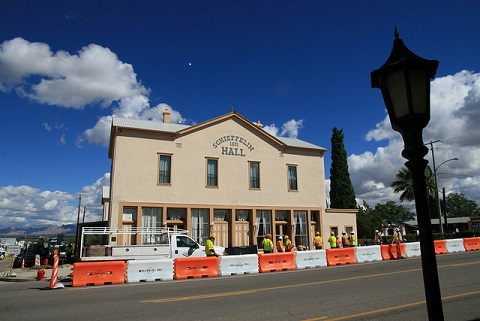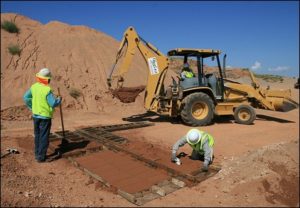The Arizona Department of Transportation (ADOT) has made what it calls an “architecturally challenging” decision to carry out both historic preservation work and transportation safety work in one of the nation’s most significant and infamous towns — Tombstone.
Tombstone was one of the last frontier boomtowns in the American Old West. In its heyday, it produced millions of dollars of silver bullion and is best known as the site of the Gunfight at the OK Corral. There, ADOT is shoring up water-damaged sections of a local historic landmark called Schieffelin Hall, named for 19th century resident and silver prospector Ed Schieffelin.

Arizona DOT is using adobe bricks to shore up water-damaged sections of a local historic landmark, Schieffelin Hall. Photo: Arizona DOT
“Carrying out preservation work with very unique materials alongside one of our highway projects is not what we do every day,” says ADOT Southeast District Engineer Bill Harmon.
Preservation Work
“But in this case, it was a natural fit. We were part of the scope of work for both projects. They both are being carried out in Tombstone’s Historic District. And ADOT is proud to be helping restore and preserve a treasured National Landmark.”
The unique materials Harmon is referring to are adobe bricks. ADOT is shoring up the Hall using replacement bricks that are being painstakingly produced using 19th century techniques. The fabrication process is taking place at a mine not far away in Cochise County by a crew headed up by a third-generation adobe maker. Precise historic replication will enable the new bricks to tightly weld to the remaining original bricks, thus increasing stability and also helping to fend off more water damage.
To create the bricks, wooden molds are set down and a slurry mixture of sand, silt, clay and grass is poured into the forms. After the mixture sits for a day or two and the bricks have taken shape, the forms are removed and the bricks are stacked in the sun to completely dry, a process that can take several weeks. Once the bricks arrive on site at the Hall, they are put into place and secured with a mud and straw mixture that functions like mortar. Finally, a layer of stucco is added on top to conform to the rest of the building’s façade.

Crews create adobe bricks for restoration of the Schieffelin Hall using historic techniques. Photo: Arizona DOT
Besides replacing some of the bricks, ADOT also will add a porch to the Hall to replace the original one removed in the early 1900s. Its corrugated metal roof will be supported by wooden posts, and a downspout will be incorporated to carry away rainwater.
Funding for the preservation work comes from a FHWA Transportation Enhancement (TE) grant awarded to the City of Tombstone. The TE grant was the culmination of several years of hard work involving numerous groups including ADOT, the State Historic Preservation Office (SHPO), the Tombstone Restoration Commission, the Federal Highway Administration, and the National Park Service, as well as local government, businesses, and citizens. All work is being carried out according to guidelines from the Department of Interior’s Standards for Rehabilitation, a technique required by the National Historic Preservation Act.
Safety Work
In the same neighborhood as its preservation work, ADOT also is carrying out an associated project to improve motorist and pedestrian safety along the Fremont Street portion of State Route 80 where Schieffelin Hall stands. Funding for the highway safety project comes from FHWA’s Highway Safety Improvement Program under MAP-21 and from state gas-tax dollars.
Key safety features being installed under the ADOT grant, begun in August of this year, include the following:
- narrowing a portion of Fremont Street from 68 feet to 44 feet to make room for sidewalks and other pedestrian improvements;
- installing landscaping and constructing sturdy concrete sidewalks that look like weathered wood to deter pedestrians from jaywalking; and
- providing continuous street lighting throughout the area.
He continues, “Sadly, part of the impetus for installing extra rigorous safety features came from a tragic crash that took place here in Tombstone in 2009 involving two tourists. After that happened, ADOT and the city of Tombstone began to work together even more closely to implement a range of advanced pedestrian safety improvements.”
In 2010, he says, ADOT and the city of Tombstone completed a comprehensive traffic study soon after the accident. Short-term actions that ensued included road striping, parking restrictions, and reduced speed limits. The study also recommended several longer-term improvements.
Besides the key pedestrian safety features, the project also entails repaving the roadway and constructing new curbs with handicap ramps,, removing an obsolete pedestrian bridge, and installing an irrigation system for landscaping. Driveways not needed by property owners will be closed, others will be improved to meet current standards.
“Construction for both projects is moving forward steadily,” Harmon says. “Our schedule calls for completing both in the spring of 2016. The value of the two projects, combined, is right at $1 million.”
Groundwork
According to Harmon, while it’s not uncommon for ADOT to be involved in the preservation of historic properties through the Transportation Enhancement grants program, it is unusual for the agency to play a role in the preservation of a National Historic Landmark, including such an architecturally challenging project. As he puts it: “This project truly is one of a kind.”
Extensive collaboration took place so that both historic preservation and improved safety goals were met, he continues. The two projects were evaluated together under one NEPA categorical exclusion document. ADOT retained historic preservation specialists to help during the design and construction phases. The restoration concepts were reviewed and approved by the State Historic Preservation Officer. Detailed plans were prepared based on old photographs plus an onsite investigation of the soundness of the walls.
To meet the requirements of both Section 106 of the National Historic Preservation Act (NHPA) and Section 4(f) of the Transportation Act, AZDOT incorporated several historic preservation features. For example, to mitigate the porch’s potential impact on the historic adobe material, the design was tweaked so to have the porch be a free-standing structure rather than be attached. And the street lighting that was installed was carefully chosen in conjunction with the State Historic Preservation Office (SHPO) so as to carry forward aspects of period lighting design.
“Other state DOTs could, and may well be, carrying out similar community improvement projects under what has become the Transportation Alternatives program,” says Harmon.
“But in addition to the challenges of coordination across many different groups, there is also the issue of funding, including matching funds. We were very fortunate in this project to have both the funding and a great group of people who were willing to do what it took to make this happen.”
The project’s most memorable moment to date? Easy one, is Harmon’s reply. It was the day some cattle wandered into the brick-making area and trampled over some of the fresh adobe.
“Not a typical delay at a modern construction site,” he says, “but it probably happened more than once a century or so ago. I guess it’s to be expected when, for historic preservation’s sake, we decide to work on the cutting edge of low technology.”
For more information, link to the ADOT blog post and video or contact Dustin Krugel, ADOT Public Information Officer, at [email protected].

